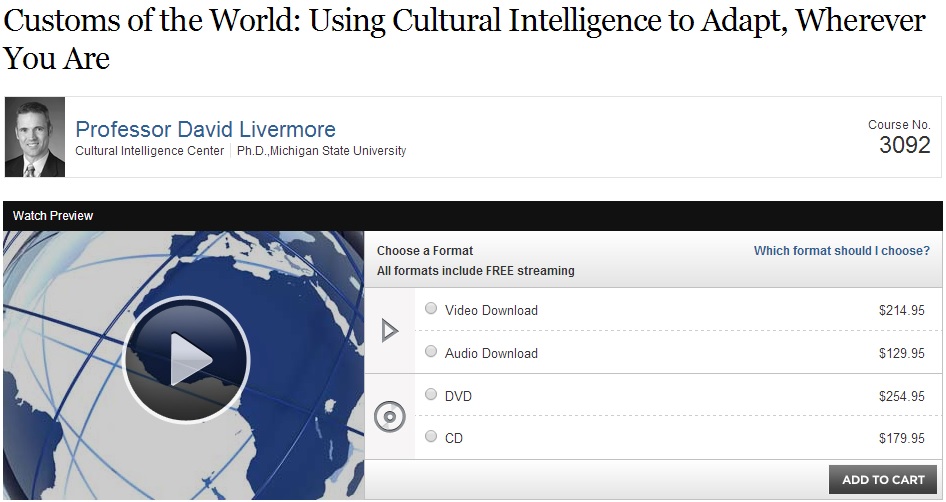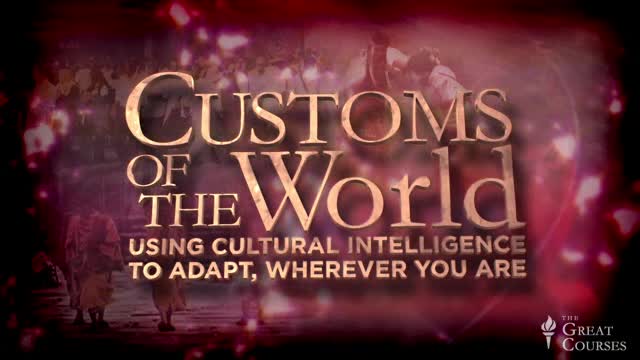
The Creative Thinker’s Toolkit
WEB-Rip | WMV | WMV3 @ 1 Mbit/s | 640×360 | WMA Stereo @ 128 Kbit/s 44 KHz | 12 Hours | 10.3 GB
Genre: Science, Sociology, Cultural Intelligence | Language: English | PDF Included
| You’ve heard it before: When in Rome, do as the Romans do. The concept of cultural adaptation is hardly new. But is it always the best approach? In our increasingly globalized world, the need for cross-cultural understanding has never been more essential to our success in life, both personally and professionally—yet how can we possibly adapt to all the cultures surrounding us?
Whether you are tasked with building business relationships internationally, wish to be a more respectful traveler, or simply want to be a more thoughtful, global citizen at home, developing cultural intelligence, or CQ, is paramount. Of course, we’re not born with a high level of CQ, and a country’s customs, values, and expectations may be hidden or too subtle and bewildering to pick up on. Common sense alone isn’t enough to help us navigate the cultural differences that can lead to costly misunderstandings, tension, and embarrassment. But groundbreaking research is revealing what we can do to improve our cultural intelligence. With the right guidance, CQ is a capability anyone can develop and hone. the ability to make cross-cultural adjustments more rapidly; In Customs of the World: Using Cultural Intelligence to Adapt, Wherever You Are, you’ll learn both the values held by cultures around the world and how those values influence behavior so you can successfully accomplish your objectives, no matter what the cultural context. Taught by Professor David Livermore of the Cultural Intelligence Center, these 24 eye-opening lectures address dynamics and customs related to working, socializing, dining, and marriage and family—all the areas necessary to help you function with a greater level of respect and effectiveness wherever you go. In this course, you’ll encounter practical tips and crucial context for greeting, interacting with, and even managing people from other parts of the world. But you’ll also see that being culturally intelligent doesn’t mean fully adapting to the cultural preferences of everyone you meet. In fact, sometimes it’s better not to adapt. As Professor Livermore notes, culture is like an iceberg, with only a tiny fraction of it in view. The most significant part of a culture lies invisibly beneath the surface. Failure to account for this can result in extensive damage. A Guide to the World’s Archetypes Why do people from certain cultures have little regard for time? Customs of the World illuminates how thousands of years of history and a legacy of practices passed down through generations create differences in behavior that may seem rude or strange to some and perfectly acceptable to others. In the first half of the course, you’ll analyze 10 cultural value dimensions that researchers have identified as helpful for comparing cultures; and you’ll see how these “sophisticated stereotypes” or “archetypes” play out in day-to-day lives. For example, you’ll explore the differences between cultures that adhere to clock time, as in the United States, and cultures that operate on event time, as in Brazil. And you’ll identify the differences between “being” cultures such as in Mexico and “doing” cultures like that of the Japanese. Some of the other dimensions you’ll explore: Individualist versus collectivist: In the United States, the will of the individual is championed, whereas in India, priority lies with the family unit. High power versus low power distance: Some cultures are uncomfortable with visible inequality in power and status, while others accept it. High-context versus low-context communication: Speaking bluntly is appreciated in some countries, while conversational directness is avoided at all costs in others. Neutral versus affective: Many cultures, such as that of the Japanese, show minimal outward signs of emotion. Others, like Italian culture, are highly expressive. Universalist versus particularist: Some cultures believe rules should apply to everyone equally, while others think each situation and person needs to be handled uniquely. Be More Savvy at Home and Abroad An awareness of these cultural dimensions will guide you as you navigate real-world interactions. Your new understanding of power distance, for example, can be applied cross-culturally when addressing people at various levels of status; And you’ll learn a plethora of other practical tips for dealing with business associates and friends from other nations, whether on your home turf or theirs. Span the Globe in 24 Lectures In the second half of the course, you’ll look at 10 cultural clusters around the world. Once you combine your understanding of the 10 cultural dimensions with your knowledge of these 10 global clusters, you’ll have strategic insight into how to be more effective as you live, work, and travel in our globalized world. From the Nordic, Germanic, and Eastern European clusters to the countries in Latin America, Confucian Asia, and Sub-Saharan Africa, you’ll traverse the continents, expanding your awareness and comprehension of people’s customs, values, aspirations, and motivations. Discussion of each cluster concludes with “do’s and taboos” for interacting with people from those countries; however, Professor Livermore is careful to point out that cultural intelligence can’t be reduced to a simple list of do’s and don’ts. It requires a more nuanced perspective that balances an understanding of cultural norms with your knowledge of who you are, what you believe, and the particular situation and people involved. Only then can you determine how to behave in ways that are both respectful and productive. Learn from a Sought-After International Speaker As an adviser to leaders of Fortune 500 companies, nonprofits, and governments who has worked in more than 100 countries around the world, Professor Livermore brings an unparalleled depth of cross-cultural knowledge and sensitivity to these lectures. Insights and cautionary tales culled from his decades of travel and experiences living abroad lend a personal touch to the presentation, while detailed maps, charts, portraits, and on-screen text guide your learning. Clear, organized, engaging, and, best of all, practical, this course is an indispensible guide for our times. So make an investment in your cultural intelligence with Customs of the World. |
| 24 Lectures
01 Culture Matters |


Download uploaded
http://uploaded.net/file/xt8p77va/COTW.part01.rar
http://uploaded.net/file/s7hsce57/COTW.part02.rar
http://uploaded.net/file/64mr9ajk/COTW.part03.rar
http://uploaded.net/file/th15ewic/COTW.part04.rar
http://uploaded.net/file/mh7rxje6/COTW.part05.rar
http://uploaded.net/file/ulueah2y/COTW.part06.rar
http://uploaded.net/file/ilscn9rb/COTW.part07.rar
http://uploaded.net/file/y9w3qdzv/COTW.part08.rar
http://uploaded.net/file/8uiymtrt/COTW.part09.rar
http://uploaded.net/file/44znh14u/COTW.part10.rar
http://uploaded.net/file/9rdncwt5/COTW.part11.rar
http://uploaded.net/file/z0o2ee2n/COTW.part12.rar
Download rapidgator
http://rg.to/file/26a6dd42668c0bc9bbe38458e6b37055/COTW.part01.rar.html
http://rg.to/file/bd907d67aa9667e083a73261745b6e2b/COTW.part02.rar.html
http://rg.to/file/edaf9fcb68774f697eeb4fe561629b98/COTW.part03.rar.html
http://rg.to/file/939d03b2c5599a9643d4dc86d2a0c725/COTW.part04.rar.html
http://rg.to/file/2d09ebcf3d6d79ca2ff471e8b0cf3d65/COTW.part05.rar.html
http://rg.to/file/02dab769b059c516475d1e6db2922ac9/COTW.part06.rar.html
http://rg.to/file/756ab29ea914894963220f37f0ba24f6/COTW.part07.rar.html
http://rg.to/file/a9f49aff90fb090a94bb378c1caaba8b/COTW.part08.rar.html
http://rg.to/file/9d206cc440ddbef6c58bfe044e3ec044/COTW.part09.rar.html
http://rg.to/file/899d028e2bd2c98ea5fbf81e7d28477b/COTW.part10.rar.html
http://rg.to/file/add3c796604e35564017606389a0a315/COTW.part11.rar.html
http://rg.to/file/93a3d12accb90c7ac1257e1c763f434a/COTW.part12.rar.html
Download 百度云
你是VIP 1个月(1 month)赞助会员,
转载请注明:0daytown » Customs of the World – Using Cultural Intelligence to Adapt, Wherever You Are